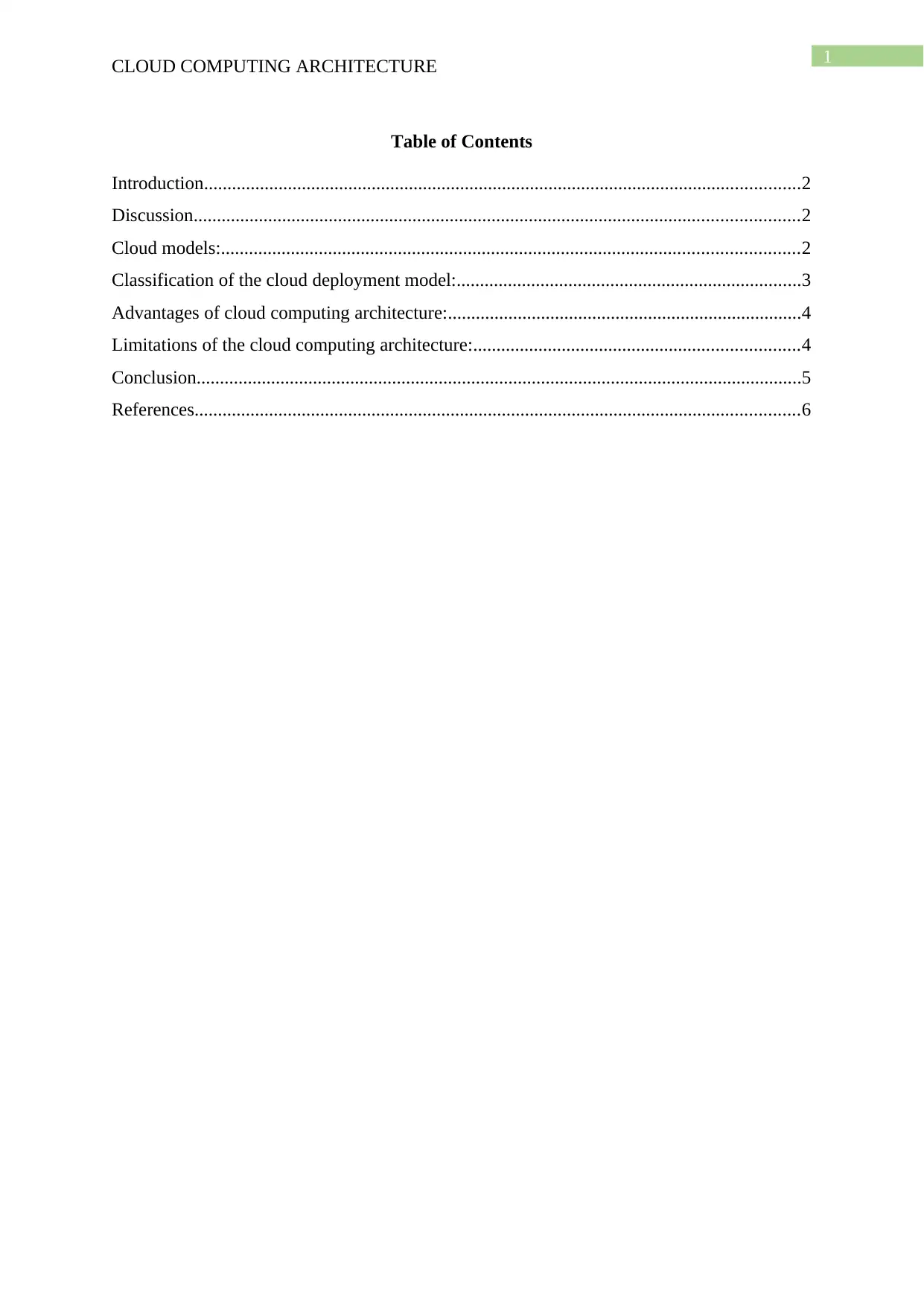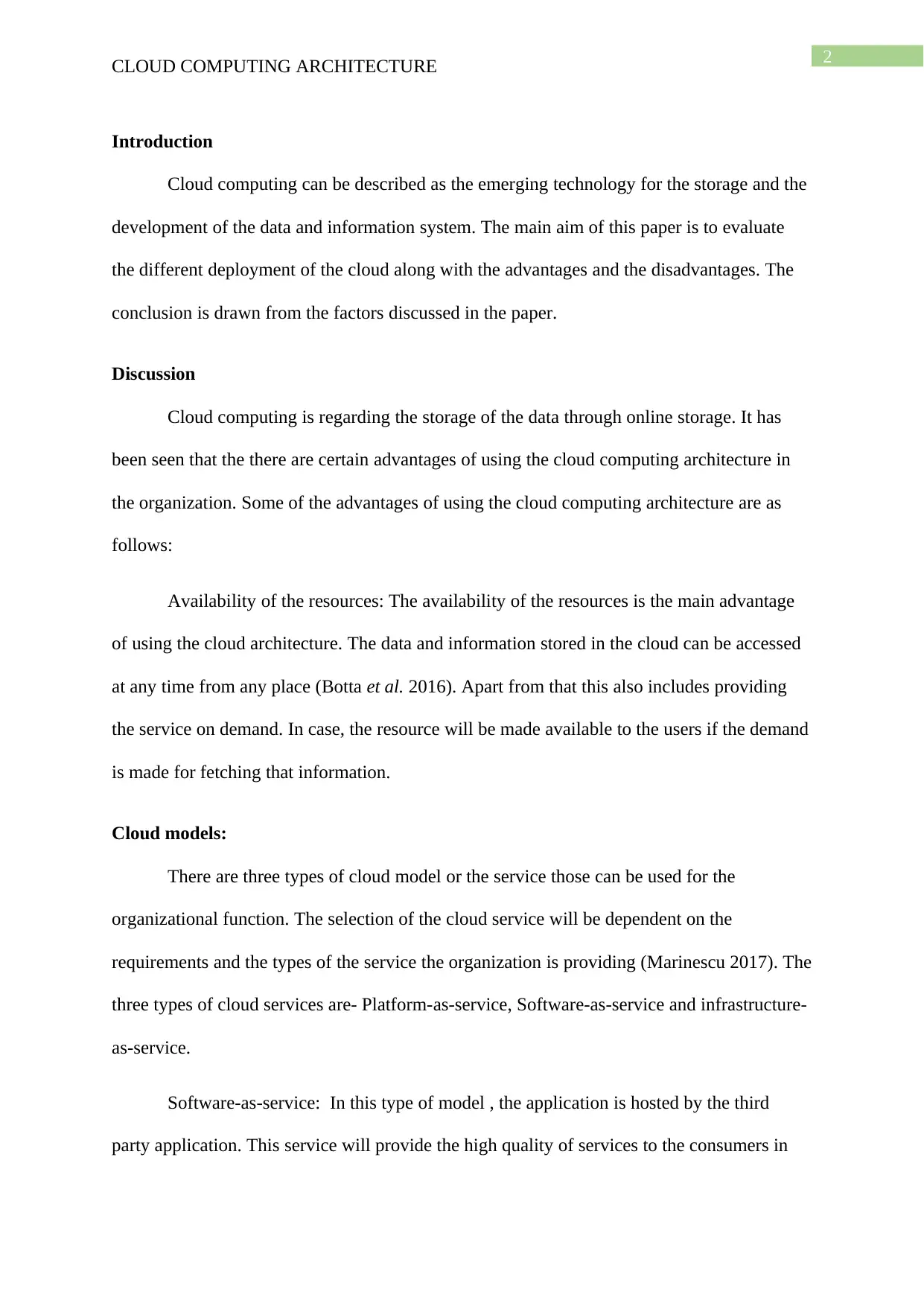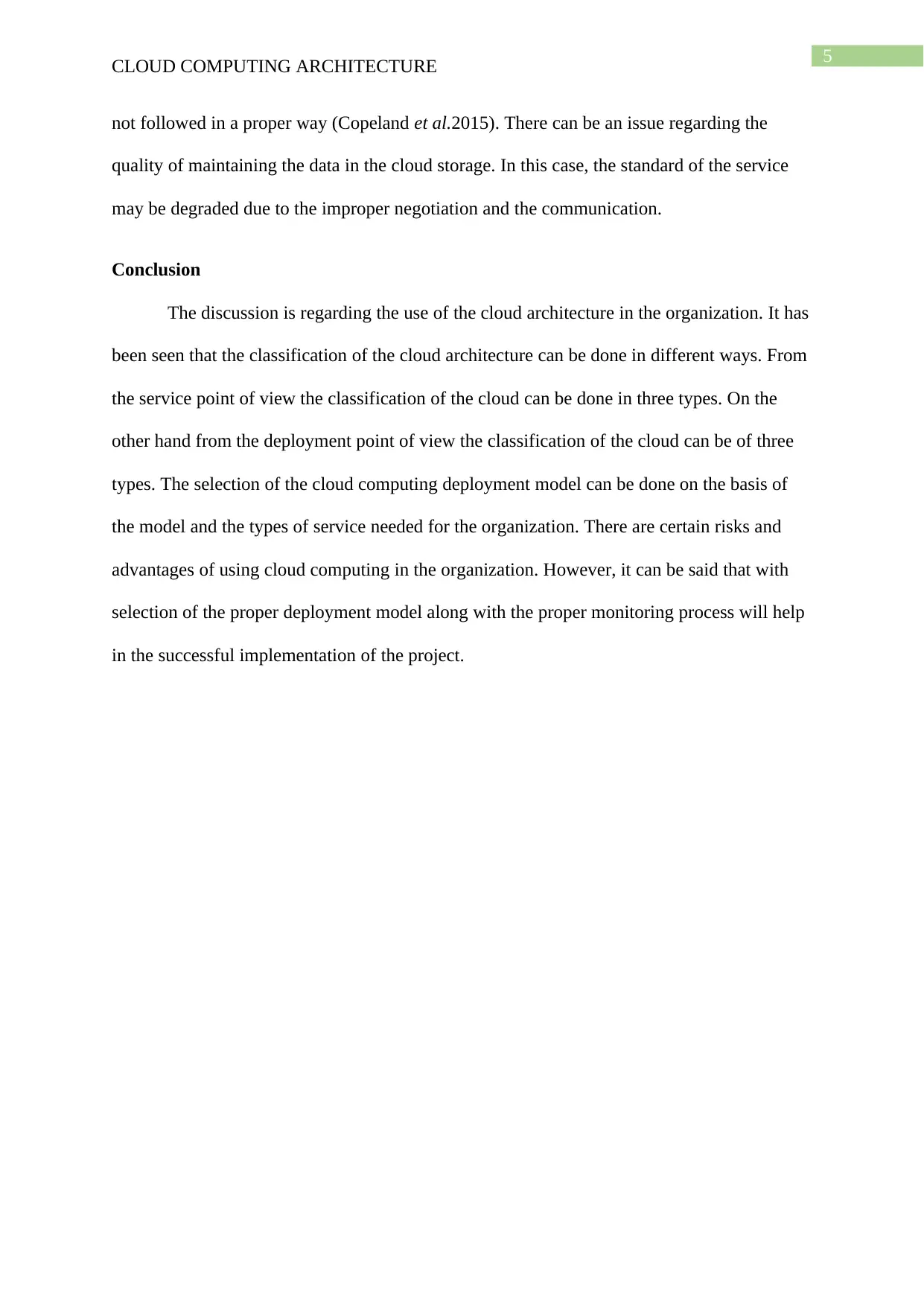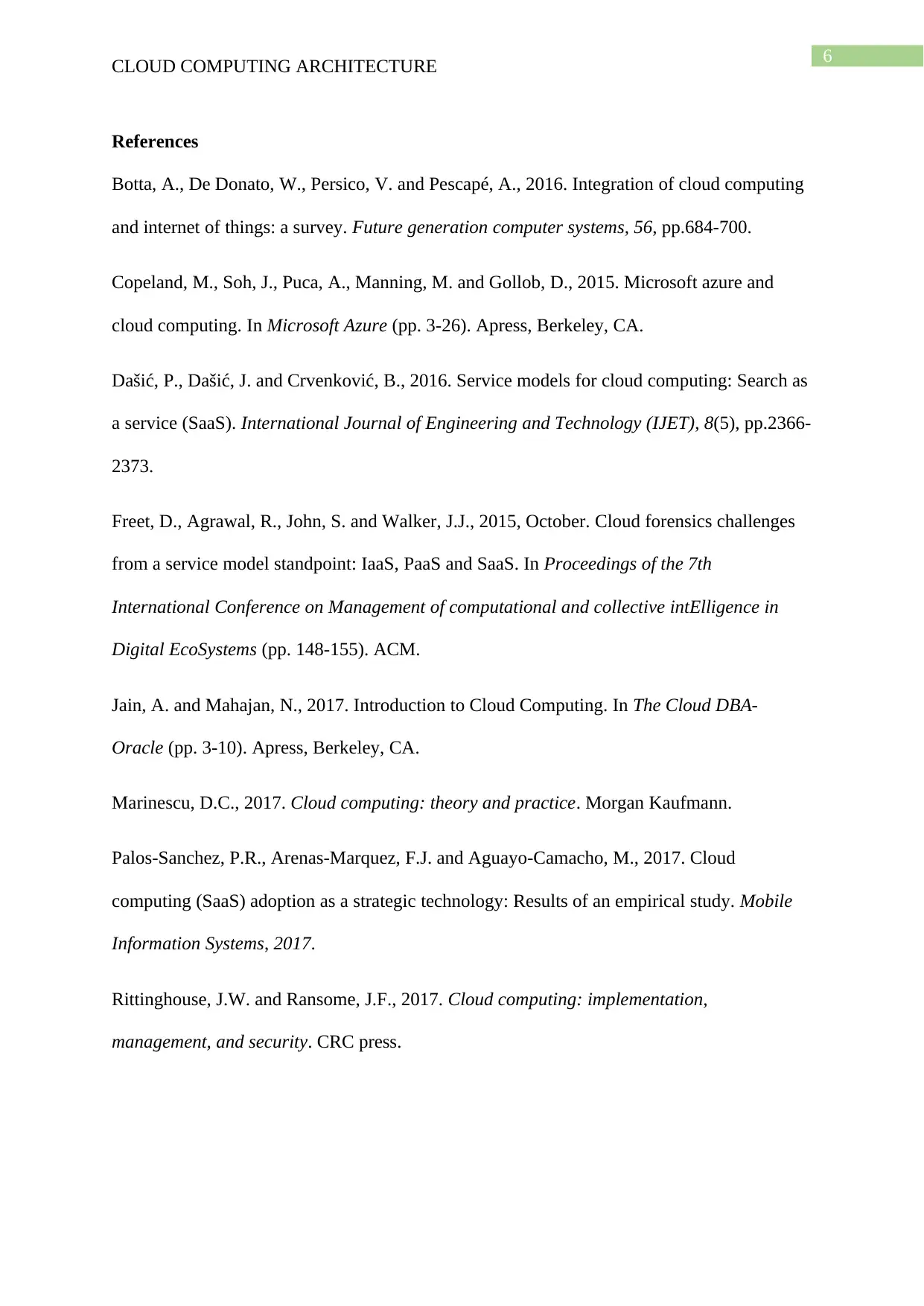Cloud Computing Architecture
VerifiedAdded on 2023/01/10
|7
|1495
|95
AI Summary
This article discusses the different deployment models of cloud computing architecture, including public, private, and hybrid clouds. It also explores the advantages and limitations of using cloud computing in organizations.
Contribute Materials
Your contribution can guide someone’s learning journey. Share your
documents today.

Running head: CLOUD COMPUTING ARCHITECTURE
CLOUD COMPUTING ARCHITECTURE
Name of the Student:
Name of the University:
Author Note:
CLOUD COMPUTING ARCHITECTURE
Name of the Student:
Name of the University:
Author Note:
Secure Best Marks with AI Grader
Need help grading? Try our AI Grader for instant feedback on your assignments.

1
CLOUD COMPUTING ARCHITECTURE
Table of Contents
Introduction................................................................................................................................2
Discussion..................................................................................................................................2
Cloud models:............................................................................................................................2
Classification of the cloud deployment model:..........................................................................3
Advantages of cloud computing architecture:............................................................................4
Limitations of the cloud computing architecture:......................................................................4
Conclusion..................................................................................................................................5
References..................................................................................................................................6
CLOUD COMPUTING ARCHITECTURE
Table of Contents
Introduction................................................................................................................................2
Discussion..................................................................................................................................2
Cloud models:............................................................................................................................2
Classification of the cloud deployment model:..........................................................................3
Advantages of cloud computing architecture:............................................................................4
Limitations of the cloud computing architecture:......................................................................4
Conclusion..................................................................................................................................5
References..................................................................................................................................6

2
CLOUD COMPUTING ARCHITECTURE
Introduction
Cloud computing can be described as the emerging technology for the storage and the
development of the data and information system. The main aim of this paper is to evaluate
the different deployment of the cloud along with the advantages and the disadvantages. The
conclusion is drawn from the factors discussed in the paper.
Discussion
Cloud computing is regarding the storage of the data through online storage. It has
been seen that the there are certain advantages of using the cloud computing architecture in
the organization. Some of the advantages of using the cloud computing architecture are as
follows:
Availability of the resources: The availability of the resources is the main advantage
of using the cloud architecture. The data and information stored in the cloud can be accessed
at any time from any place (Botta et al. 2016). Apart from that this also includes providing
the service on demand. In case, the resource will be made available to the users if the demand
is made for fetching that information.
Cloud models:
There are three types of cloud model or the service those can be used for the
organizational function. The selection of the cloud service will be dependent on the
requirements and the types of the service the organization is providing (Marinescu 2017). The
three types of cloud services are- Platform-as-service, Software-as-service and infrastructure-
as-service.
Software-as-service: In this type of model , the application is hosted by the third
party application. This service will provide the high quality of services to the consumers in
CLOUD COMPUTING ARCHITECTURE
Introduction
Cloud computing can be described as the emerging technology for the storage and the
development of the data and information system. The main aim of this paper is to evaluate
the different deployment of the cloud along with the advantages and the disadvantages. The
conclusion is drawn from the factors discussed in the paper.
Discussion
Cloud computing is regarding the storage of the data through online storage. It has
been seen that the there are certain advantages of using the cloud computing architecture in
the organization. Some of the advantages of using the cloud computing architecture are as
follows:
Availability of the resources: The availability of the resources is the main advantage
of using the cloud architecture. The data and information stored in the cloud can be accessed
at any time from any place (Botta et al. 2016). Apart from that this also includes providing
the service on demand. In case, the resource will be made available to the users if the demand
is made for fetching that information.
Cloud models:
There are three types of cloud model or the service those can be used for the
organizational function. The selection of the cloud service will be dependent on the
requirements and the types of the service the organization is providing (Marinescu 2017). The
three types of cloud services are- Platform-as-service, Software-as-service and infrastructure-
as-service.
Software-as-service: In this type of model , the application is hosted by the third
party application. This service will provide the high quality of services to the consumers in

3
CLOUD COMPUTING ARCHITECTURE
the demand basis. Some of the examples of the software-as –service are Salesforce.com,
netsuit, facebook , google
Platform –as-service: The application in this service is done by the clients itself.
Platform as service will provide the consumers to develop their own application through
providing them a proper IDE. Apart from that it is the responsibility of the consumers to
maintain those developed application. Some of the examples of the platform-as-service
service are- Amazon Web, Azure, rockspace.
Infrastructure-as-service: Infrastructure is provided to the clients in the organization.
In this situation, the organization itself is responsible for the organization’s service. Some of
the examples of the Infrastructure of service are- OpSource, NTT Communication, at&t,
terremark.
Classification of the cloud deployment model:
The cloud deployment model can be of three types- public cloud, private cloud and hybrid
cloud.
Public cloud: Public cloud service is provided by the cloud service provider. The data
and the information stored in the public cloud can be accessed by any of the users (Jain and
Mahajan 2017). However, the security of the public cloud is maintained by the cloud service
provider. Some of the public cloud service providers are- Amazon, IBM.
Private cloud: The data and information stored in the private cloud can be managed
by the organization itself. The access of the data and information in the private cloud can be
accessed by only the employees of the organization. This type of cloud deployment model
has the highest form of the information security. However, there is a lack of flexibility in the
services provided by the private cloud.
CLOUD COMPUTING ARCHITECTURE
the demand basis. Some of the examples of the software-as –service are Salesforce.com,
netsuit, facebook , google
Platform –as-service: The application in this service is done by the clients itself.
Platform as service will provide the consumers to develop their own application through
providing them a proper IDE. Apart from that it is the responsibility of the consumers to
maintain those developed application. Some of the examples of the platform-as-service
service are- Amazon Web, Azure, rockspace.
Infrastructure-as-service: Infrastructure is provided to the clients in the organization.
In this situation, the organization itself is responsible for the organization’s service. Some of
the examples of the Infrastructure of service are- OpSource, NTT Communication, at&t,
terremark.
Classification of the cloud deployment model:
The cloud deployment model can be of three types- public cloud, private cloud and hybrid
cloud.
Public cloud: Public cloud service is provided by the cloud service provider. The data
and the information stored in the public cloud can be accessed by any of the users (Jain and
Mahajan 2017). However, the security of the public cloud is maintained by the cloud service
provider. Some of the public cloud service providers are- Amazon, IBM.
Private cloud: The data and information stored in the private cloud can be managed
by the organization itself. The access of the data and information in the private cloud can be
accessed by only the employees of the organization. This type of cloud deployment model
has the highest form of the information security. However, there is a lack of flexibility in the
services provided by the private cloud.
Secure Best Marks with AI Grader
Need help grading? Try our AI Grader for instant feedback on your assignments.

4
CLOUD COMPUTING ARCHITECTURE
Hybrid cloud: The development of the hybrid cloud is done through the merging of
both private cloud and public cloud (Rittinghouse and Ransome 2017). It has been seen that
the hybrid cloud architecture delivers both the flexibility and the security in the cloud
computing architecture. In the hybrid cloud architecture, the partial information and the data
is stored in the public cloud architecture. On the other hand the private data are stored in the
private cloud. The managing of the security of the public cloud is maintained by the public
cloud architecture (Freet et al. 2015). On the other hand the managing the security of the
private cloud can be done either by the organization or the cloud service provider. The
negotiation process can be done in a proper way regarding the maintenance of the
information security.
Some of the characteristics of the cloud architecture include on demand services, measured
service, resource polling.
Advantages of cloud computing architecture:
There are certain advantages of the cloud computing architecture. It has been seen that
the use of the cloud computing will deliver the rich use of resources (Dašić, Dašić and
Crvenković 2016). Apart from that the use of the cloud computing provides the organization
a chance regarding the mitigation of the overhead cost. This eventually increases the
efficiency and the functionality of the overall organizational functions.
Limitations of the cloud computing architecture:
There are some of the limitation regarding the use of the cloud computing
architecture. It has been seen that there may be a problem from the lack of technical support
(Palos-Sanchez Arenas-Marquez and Aguayo-Camacho 2017). Apart from that the
employees in the organization may not be habituated to handle an entirely new system. Apart
from that there is a chance of the breaching of the data if the security rules and regulations are
CLOUD COMPUTING ARCHITECTURE
Hybrid cloud: The development of the hybrid cloud is done through the merging of
both private cloud and public cloud (Rittinghouse and Ransome 2017). It has been seen that
the hybrid cloud architecture delivers both the flexibility and the security in the cloud
computing architecture. In the hybrid cloud architecture, the partial information and the data
is stored in the public cloud architecture. On the other hand the private data are stored in the
private cloud. The managing of the security of the public cloud is maintained by the public
cloud architecture (Freet et al. 2015). On the other hand the managing the security of the
private cloud can be done either by the organization or the cloud service provider. The
negotiation process can be done in a proper way regarding the maintenance of the
information security.
Some of the characteristics of the cloud architecture include on demand services, measured
service, resource polling.
Advantages of cloud computing architecture:
There are certain advantages of the cloud computing architecture. It has been seen that
the use of the cloud computing will deliver the rich use of resources (Dašić, Dašić and
Crvenković 2016). Apart from that the use of the cloud computing provides the organization
a chance regarding the mitigation of the overhead cost. This eventually increases the
efficiency and the functionality of the overall organizational functions.
Limitations of the cloud computing architecture:
There are some of the limitation regarding the use of the cloud computing
architecture. It has been seen that there may be a problem from the lack of technical support
(Palos-Sanchez Arenas-Marquez and Aguayo-Camacho 2017). Apart from that the
employees in the organization may not be habituated to handle an entirely new system. Apart
from that there is a chance of the breaching of the data if the security rules and regulations are

5
CLOUD COMPUTING ARCHITECTURE
not followed in a proper way (Copeland et al.2015). There can be an issue regarding the
quality of maintaining the data in the cloud storage. In this case, the standard of the service
may be degraded due to the improper negotiation and the communication.
Conclusion
The discussion is regarding the use of the cloud architecture in the organization. It has
been seen that the classification of the cloud architecture can be done in different ways. From
the service point of view the classification of the cloud can be done in three types. On the
other hand from the deployment point of view the classification of the cloud can be of three
types. The selection of the cloud computing deployment model can be done on the basis of
the model and the types of service needed for the organization. There are certain risks and
advantages of using cloud computing in the organization. However, it can be said that with
selection of the proper deployment model along with the proper monitoring process will help
in the successful implementation of the project.
CLOUD COMPUTING ARCHITECTURE
not followed in a proper way (Copeland et al.2015). There can be an issue regarding the
quality of maintaining the data in the cloud storage. In this case, the standard of the service
may be degraded due to the improper negotiation and the communication.
Conclusion
The discussion is regarding the use of the cloud architecture in the organization. It has
been seen that the classification of the cloud architecture can be done in different ways. From
the service point of view the classification of the cloud can be done in three types. On the
other hand from the deployment point of view the classification of the cloud can be of three
types. The selection of the cloud computing deployment model can be done on the basis of
the model and the types of service needed for the organization. There are certain risks and
advantages of using cloud computing in the organization. However, it can be said that with
selection of the proper deployment model along with the proper monitoring process will help
in the successful implementation of the project.

6
CLOUD COMPUTING ARCHITECTURE
References
Botta, A., De Donato, W., Persico, V. and Pescapé, A., 2016. Integration of cloud computing
and internet of things: a survey. Future generation computer systems, 56, pp.684-700.
Copeland, M., Soh, J., Puca, A., Manning, M. and Gollob, D., 2015. Microsoft azure and
cloud computing. In Microsoft Azure (pp. 3-26). Apress, Berkeley, CA.
Dašić, P., Dašić, J. and Crvenković, B., 2016. Service models for cloud computing: Search as
a service (SaaS). International Journal of Engineering and Technology (IJET), 8(5), pp.2366-
2373.
Freet, D., Agrawal, R., John, S. and Walker, J.J., 2015, October. Cloud forensics challenges
from a service model standpoint: IaaS, PaaS and SaaS. In Proceedings of the 7th
International Conference on Management of computational and collective intElligence in
Digital EcoSystems (pp. 148-155). ACM.
Jain, A. and Mahajan, N., 2017. Introduction to Cloud Computing. In The Cloud DBA-
Oracle (pp. 3-10). Apress, Berkeley, CA.
Marinescu, D.C., 2017. Cloud computing: theory and practice. Morgan Kaufmann.
Palos-Sanchez, P.R., Arenas-Marquez, F.J. and Aguayo-Camacho, M., 2017. Cloud
computing (SaaS) adoption as a strategic technology: Results of an empirical study. Mobile
Information Systems, 2017.
Rittinghouse, J.W. and Ransome, J.F., 2017. Cloud computing: implementation,
management, and security. CRC press.
CLOUD COMPUTING ARCHITECTURE
References
Botta, A., De Donato, W., Persico, V. and Pescapé, A., 2016. Integration of cloud computing
and internet of things: a survey. Future generation computer systems, 56, pp.684-700.
Copeland, M., Soh, J., Puca, A., Manning, M. and Gollob, D., 2015. Microsoft azure and
cloud computing. In Microsoft Azure (pp. 3-26). Apress, Berkeley, CA.
Dašić, P., Dašić, J. and Crvenković, B., 2016. Service models for cloud computing: Search as
a service (SaaS). International Journal of Engineering and Technology (IJET), 8(5), pp.2366-
2373.
Freet, D., Agrawal, R., John, S. and Walker, J.J., 2015, October. Cloud forensics challenges
from a service model standpoint: IaaS, PaaS and SaaS. In Proceedings of the 7th
International Conference on Management of computational and collective intElligence in
Digital EcoSystems (pp. 148-155). ACM.
Jain, A. and Mahajan, N., 2017. Introduction to Cloud Computing. In The Cloud DBA-
Oracle (pp. 3-10). Apress, Berkeley, CA.
Marinescu, D.C., 2017. Cloud computing: theory and practice. Morgan Kaufmann.
Palos-Sanchez, P.R., Arenas-Marquez, F.J. and Aguayo-Camacho, M., 2017. Cloud
computing (SaaS) adoption as a strategic technology: Results of an empirical study. Mobile
Information Systems, 2017.
Rittinghouse, J.W. and Ransome, J.F., 2017. Cloud computing: implementation,
management, and security. CRC press.
1 out of 7
Related Documents
Your All-in-One AI-Powered Toolkit for Academic Success.
+13062052269
info@desklib.com
Available 24*7 on WhatsApp / Email
![[object Object]](/_next/static/media/star-bottom.7253800d.svg)
Unlock your academic potential
© 2024 | Zucol Services PVT LTD | All rights reserved.


